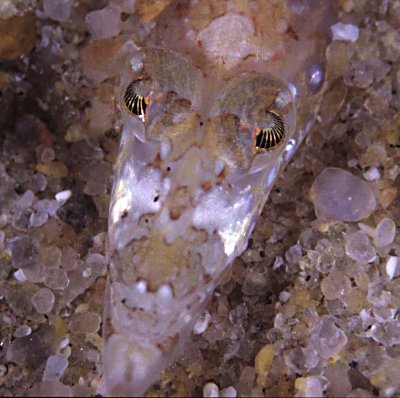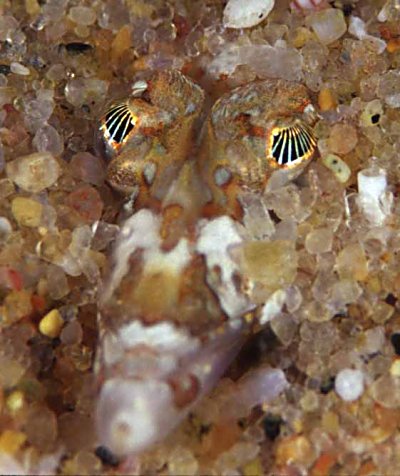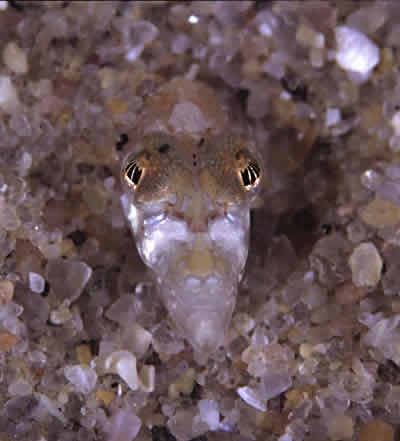

Conducted by

Sponsored by
WOW! Photo, December 2002
Eugene describes his encounter:
" This picture of a Sanddiver (Trichonotus) was taken recently at the Sodwana Shoot-Out Competition by me. I started attempting to capture this little very elusive and shy fellow on film 3 months ago. It has put me through many trials and tribulations, with many failed attempts. This species is impossible to spot as they dive into the sand faster than the eye can see and then only sometimes stick their little noses and faces out from their sand hide-out. So spotting them can only be done knowing where they live and then watching carefully for a dashing movement. Then they need to be found in the sand with torches and stalked very carefully! If you can get closer than 2 feet from this little fellow (you are very lucky if you can), you can attempt a shot. You need to anticipate the sea currents that throw up sand all the time and a very nervous little model, that will dart off in a flash and usually just before the critical moment of shutter release! You need to use dedicated macro lenses and in my case I used the 105 mm Nikkor lens with a 2 times teleconverter (therefor forfeiting autofocus with a 2-3 mm depth of field!), in order to get the close-up portrait shot. Your reward however is awesome as you stare into those amazingly beautiful eyes, with grid-iron gold irises, never captured on film before! To add to the challenge, I decided to see if I could possibly capture the Sand-diver image on film for the Sodwana Shoot-Out Challenge (limited film and limited time - competition format). This image is the result of the shoot-out! It did not impress the judges, but at least I had the satisfaction of capturing this species close-up on film for the first time, with its fantastic eyes, for all judges and competitors to see! ".
Well done Eugene; this photo shows what dedication to capturing unusual fishes on film can result in - superb images! Phil Heemstra gives us the following information on this fascinating group of elusive fishes:
The family Trichonotidae (sand divers) comprises a single genus, Trichonotus, with seven species. The elongate body and pointed head, with projecting lower jaw facilitate diving into the sand when these fish are frightened or pursued by a predator. We have apparently only one species, Trichonotus marleyi (Smith, 1936) in our area. The collector, H.W. Bell-Marley, described the fish as "Above amber, studded with turquoise blue and red dots. The lower surface faint rosy. Anal [fin] and ventrals [pelvic fins] with numerous dark red dots. Eye with about 20 golden lines, umbrous red above".Eugene Viljoen’s amazing photos show the intricate appendages from the umbralacrum over the pupil. A similar but more simple umbralacrum is also present in the eyes of some flatheads (Family Platycephalidae). They also live in shallow sandy areas, where bright sunlight makes an environment of high albedo. As the sunlight intensifies, the appendages of the umbralacrum expand to reduce the light entering the eye. A similar pupillary adaptation is also seen in camels and llamas, which live in bright, sandy desert habitats.
Eugene’s photos also show the excellent camouflage of the silvery and amber blotches on the head, which match the quartz and calcareous sand grains of these benthic fishes. Sand divers occur singly or in small groups, hovering near the bottom where they feed on zooplankton. Males are larger and more colourful than females; they have higher fins than the females, and the first two dorsal fin rays of adult males of T. marleyi are greatly elongated. Males are usually accompanied by a harem of several females, which they impress by erecting their fins in courtship displays. The size disparity and harem reproductive mode imply that sand divers are another of the many hermaphroditic fish families that are associated with coral reefs.
Many thanks Eugene, for sharing your WOW! PHOTO.
Eugene sent us two more pictures of these fascinating fish:


